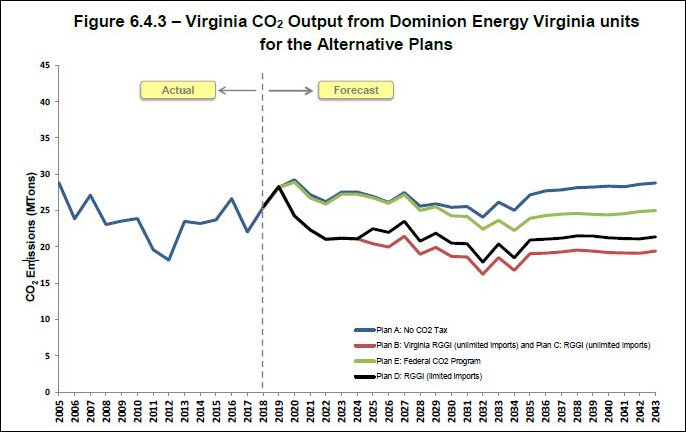
One of my goals in life is to drive Lowell Feld insane. From what I call tell, my insidious plan is working.
Lowell, the hyperbolic publisher of the left-wing Blue Virginia blog, deems me a “climate denier” and an all-around right-wing whack job. A few days ago, he included several of my Bacon’s Rebellion posts in his list of “18 of the Craziest Right-Wing Political Posts of 2018.” His main form of argumentation is taking quotes stripped of context and supporting fact, and dialing up the invective. One piece, he described as “completely baseless” and “crap,” another as “conspiracy theory lunacy,” and another as “a litany … of nonsensical right-wing tropes.” You get the idea.
Given his proclivity for substituting insults for facts and reason, Lowell seems to be losing it. I’m hoping that one more push — this post — will reduce him to gibbering madness.
When Lowell calls me a climate denier, it’s not because I deny that human activity influences the level of CO2 in the atmosphere (because I don’t), or that I deny that CO2 contributes to rising temperatures (because I don’t), or that I deny that rising temperatures contribute to sea level rise (because I don’t), or that I deny that harmful economic and ecological consequences can flow from global warming (because I don’t). I can conclude only that he calls me a denier because I don’t buy into the end-of-the-world prophecies of the anthropogenic global warming hypothesis that some (but not all) environmentalists embrace.
I could respond by calling Lowell a hysterical warming “alarmist,” but that would lower me to his level. Instead, I will present a series of facts and logical inferences which I welcome readers to support or rebut.
According to numbers readily available on the Internet, the global emissions of carbon dioxide amounted to about 36 billion tons per year in 2015. (The number has been increasing by a couple of percentage points per year since then.) The United States accounts for about 14% of that total, making it the second largest CO2 emitter in the world behind China. And the U.S. electric power industry accounts for roughly 28% of the U.S. total, amounting to about 4% of total CO2 emissions.
Virginia is just one state among 50, of course, so the Old Dominion accounts for a much smaller percentage of global CO2 emissions. The most recent Environmental Protection Agency (EPA) data says that Virginia’s electric power sector emitted CO2 at the annual rate of 31 million tons. Thus, Dominion Energy, Appalachian Power Company, and the Old Dominion Electric Cooperative collectively account for between .08% and .09% of global CO2 emissions. For the mathematically challenged, that’s between 8/100th and 9/100th of one percent.
The current debate in Virginia is how aggressively we should act to drive that number lower. The Northam administration wants Virginia to join the Regional Greenhouse Gas Initiative (RGGI), a regional carbon cap-and-trade system that has the goal of cutting Virginia’s electric-sector CO2 emissions from a 33 to 34-million-ton baseline to as low as 23.1 million tons a year by 2030.
Dominion Energy’s 2018 Integrated Resource Plan explores several different scenarios. One is the low-cost, do-nothing-extra plan. And one is “Plan D,” in which Virginia joins RGGI and, instead of importing carbon-intensive electricity from outside the state, builds its own low-carbon generating sources. Plan D, the utility projects, would increase electric rates 5.6% higher than the do-nothing-else plan. Dominion’s projections have been subjected to criticism by environmental groups, most significantly on the grounds that the utility over-estimates increasing electricity demand and, thus, the projected need for additional generating capacity. Whomever you choose to believe in that regard, both plans call for a massive expansion of solar power, extending the licenses of CO2-free nuclear power plants, implementation of demand-side management (energy efficiency) reductions equivalent to 800 GWh per year, the potential retirement of 2,785 megawatts of old coal- and gas-fired facilities, and the potential retirement of an 83-megawatt biomass facility.
Thus, even the no-extra-measures plan — which Dominion does not advocate or reject, by the way — would push CO2 emissions lower by 2030 before climbing again later that decade. The delta between the highest-carbon and lowest-carbon scenarios looks to be about 7-8 million tons per year by 2030; the gap would grow slightly in subsequent years. In other words, if Virginia adopted the most stringent scenario instead of the loosy-goosiest scenario, it would cut annual global CO2 emissions by one ton out of 4,500 and reduce global temperatures by about a thousandth of a degree Fahrenheit by the end of the century (depending upon how alarmist your projections are).
Dominion’s do-nothing-extra plan is probably pessimistic in that it doesn’t take into account future technological innovations — more efficient natural gas combustion, higher rates of solar light-to-kilowatts conversion, more economical battery storage, or the application of information technology and devices to the transmission and distribution grid. As those technologies become available in a no-extra-measures world and prove themselves, electric utilities will begin adopting them — if not voluntarily then under the prodding of the State Corporation Commissions. CO2 emissions will decline, and the gap between no-extra-measures and the low-carbon RGGI scenario will diminish.
If other states choose to move aggressively against CO2 emissions, become early adopters of new technologies, work out the kinks, and reduce the risk for us, I’m fine with that. I’m happy for Virginia to follow behind. Given our flyspeck contribution to global warming, it won’t be the end of the world.

Leave a Reply
You must be logged in to post a comment.